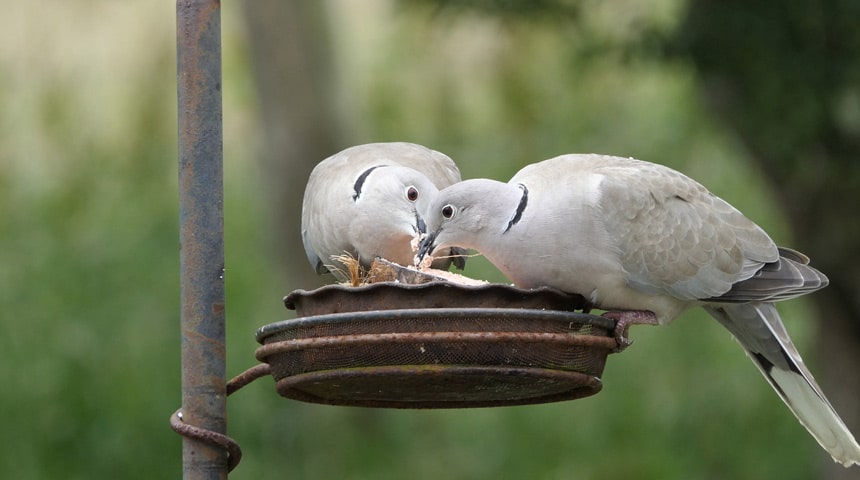
The natural diet of most columbiformes (doves and pigeons) consists mainly of the seeds of cultivated grasses and legumes. On occasion, the diet is supplemented with berries, the green parts of plants, as well as insects and grubs. Columbiformes do no hull their seeds, swallowing them instead with the shell intact. It is why these birds deliberately consume grit or gravel; the particles being necessary for the grinding of the seeds that occurs in the second stomach.
For pet doves, the ideal diet consists of a base (50-60%) of budgie, canary and or finch seed mixes, to which can be added (40-50%) a formulated diet (Lafeber® for finches or Harrison's ® Mash or Superfine). The latter has the texture of grit, and has the advantage of being well balanced, providing a baseline of nutrients for birds that pick and choose only a small number of seeds. For females that lay eggs, calcium supplementation is necessary, and can be provided by adding a supplement of crushed oyster shell to the diet. A small amount of grit may be offered to help digestion. A variety of finely chopped fruits and vegetables (leafy greens, sweet potato, carrot, berries, etc.) can be offered as well in small amounts. Examples of treats include a hard-boiled egg (including the shell), cooked beans, and a small amount of bread. A source of calcium such as crushed oyster shell should be available to laying females at all times. Pigeons and doves prefer to pick at food particles on the floor or ground (observe urban pigeons, they do the same!). It is why so many pet doves empty their food from hanging food dishes only to consume the food from the cage bottom afterwards. Although it is generally not recommended to encourage birds to spend time on the stool-soiled cage bottom, it may actually be more hygienic to offer a 'safe' eating location on the cage bottom. Food can be placed in a flat dish away from overhead perches.
Finally, be sure to always leave a bowl of fresh water available. It is possible, but not essential, to provide a small amount of grit that can help with the mechanical digestion of the seeds in the ventricle (bird's stomach).
As with all birds, special considerations are often necessary during demanding situations such as reproduction, illness, or competition. These should be addressed with your avian veterinarian. Finally, all diet changes need to be performed gradually, and the weight of the bird monitored closely to ensure that it is being maintained.
Édouard Maccolini, DVM, IPSAV (Zoological Medicine)
Julie Hébert, DVM, Dipl ABVP (avian practice)

